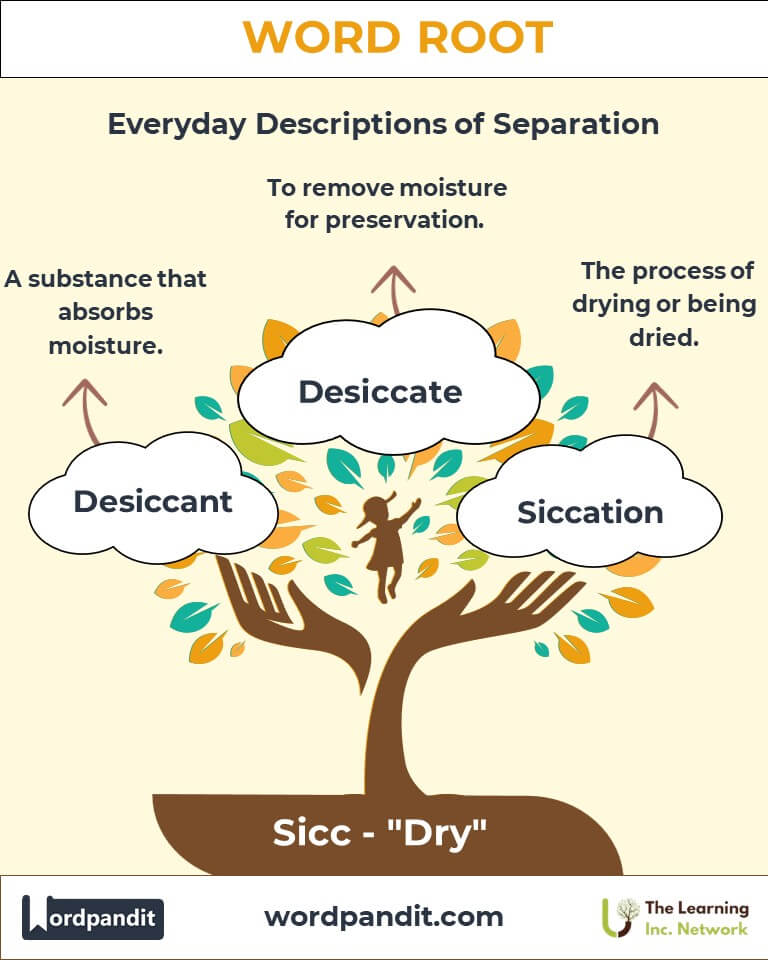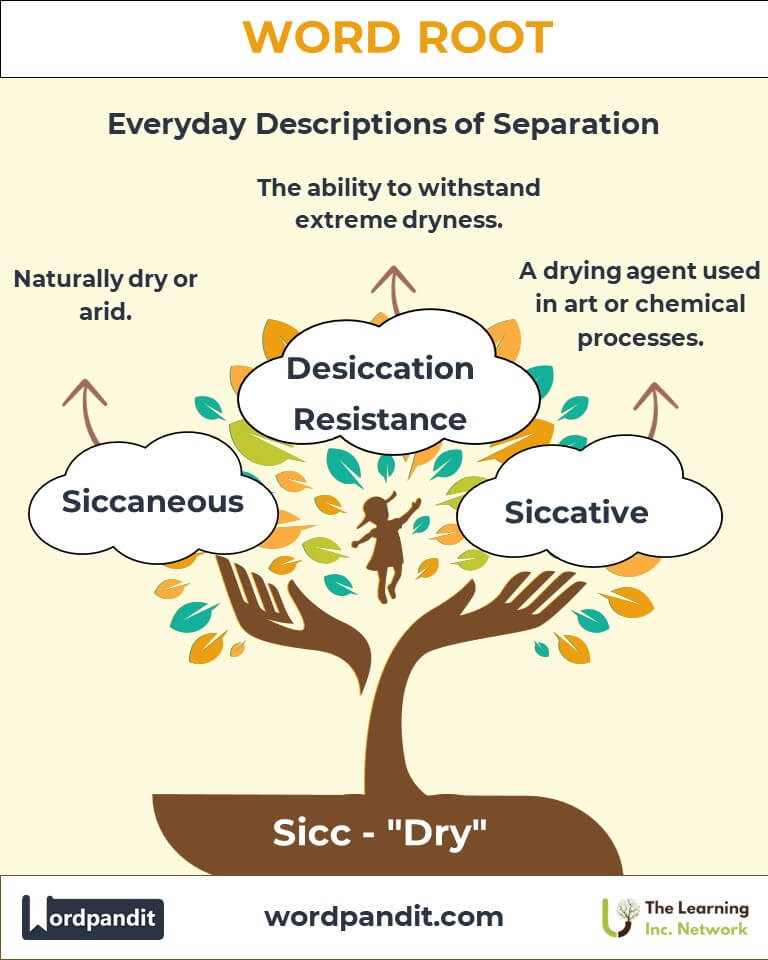Sicc: The Root of Dryness and Preservation in Language and Life
Byline: Discover the intriguing journey of the word root "sicc," derived from Latin, meaning "dry." Found in terms like "desiccate" and "siccative," this root highlights the essential interplay between dryness, preservation, and functionality across disciplines such as chemistry, art, and linguistics.

Table of Contents
- Introduction: The Essence of "Sicc"
- Etymology and Historical Journey
- Mnemonic: Unlocking the Power of Sicc
- Common Sicc-Related Terms
- Sicc Through Time
- Sicc in Specialized Fields
- Illustrative Story: Sicc in Action
- Cultural Significance of Sicc
- The Sicc Family Tree
- FAQs about the Sicc Word Root
- Test Your Knowledge: Sicc Mastery Quiz
- Conclusion: The Enduring Utility of Sicc
1. Introduction: The Essence of "Sicc"
Have you ever wondered why "desiccated" foods last so long or why artists rely on "siccative" agents in their work? The root "sicc," pronounced sik, originates from the Latin word siccus, meaning "dry." This root forms the foundation of words that revolve around removing moisture or emphasizing aridity, reflecting its enduring significance in science, art, and everyday life.

2. Etymology and Historical Journey
The root "sicc" comes from the Latin siccus, which directly translates to "dry." Ancient Romans used this term to describe physical dryness, such as arid landscapes or parched conditions. Over centuries, "sicc" evolved into scientific and technical vocabularies, forming words like "desiccate" (to dry thoroughly) and "siccative" (a drying agent), maintaining its core connection to aridity and preservation.
3. Mnemonic: Unlocking the Power of Sicc
To remember "sicc," picture a parched desert landscape under a blazing sun, embodying the essence of dryness.
Mnemonic Device: “Sicc sets the stage for dryness—think of a sunbaked desert or preserved, moisture-free foods.”
4. Common Sicc-Related Terms
- Desiccate (DEH-sih-kayt):
- Definition: To remove moisture from something, often for preservation.
- Example: "The botanist desiccated the plant samples to preserve them for future study."
- Siccative (SIK-uh-tiv):
- Definition: A drying agent, often used in art or chemical processes.
- Example: "The painter added a siccative to the oil paints to speed up drying time."
- Desiccant (DEH-sih-kant):
- Definition: A substance that absorbs moisture, often used in packaging.
- Example: "Silica gel is a common desiccant used to keep products dry."
- Siccaneous (sik-AY-nee-uhs):
- Definition: Rarely used, this term describes something that is naturally dry.
- Example: "Cacti thrive in siccaneous environments."
- Siccation (sik-AY-shun):
- Definition: The process of drying or being dried.
- Example: "The siccation of herbs ensures their flavors are preserved."
5. Sicc Through Time
- Ancient Times: The concept of "sicc" was central to early food preservation, such as drying meats and fruits under the sun.
- The Middle Ages: "Siccation" techniques evolved, particularly in medicine and alchemy, to preserve herbs and substances.
- Modern Usage: Today, "sicc" appears in contexts ranging from industrial desiccants to artistic applications of siccatives in paints.
6. Sicc in Specialized Fields
- Chemistry:
- Desiccants: Used in laboratories and packaging to remove moisture.
- Example: "Calcium chloride is a powerful desiccant for keeping environments moisture-free."
- Art:
- Siccative Agents: Essential in oil painting to speed up drying times.
- Example: "The addition of linseed oil with a siccative ensured the artwork dried evenly."
- Medicine and Biology:
- Siccation: Used in drying biological specimens for analysis or preservation.
- Example: "Siccation preserves tissue samples for microscopic examination."
- Environmental Science:
- Desiccation Resistance: Studied in plants and animals that thrive in arid environments.
- Example: "Certain desert plants have evolved desiccation resistance to survive extreme drought."
7. Illustrative Story: Sicc in Action
Dr. Sofia Ramos, an environmental scientist, studied desert ecosystems and their adaptations to dryness. She relied on desiccants to store plant samples for extended periods. Meanwhile, her artist friend Mia experimented with siccatives to create textured oil paintings inspired by desert landscapes. Through their work, Sofia and Mia demonstrated how the root "sicc" connects science, art, and the natural world.
8. Cultural Significance of Sicc
The root "sicc" highlights humanity’s enduring relationship with dryness and preservation. From ancient sun-drying techniques to modern desiccants used in food packaging, it underscores the importance of controlling moisture for survival and innovation. Artistically, siccatives have allowed for advancements in painting techniques, while scientifically, desiccants play a crucial role in industries ranging from pharmaceuticals to electronics.

9. The Sicc Family Tree
- Arid- (Latin: "dry"):
- Arid: Extremely dry.
- Aridity: The quality of being dry or barren.
- Hygr- (Greek: "wet, moisture"):
- Hygrometer: An instrument for measuring humidity.
- Hygroscopic: Tending to absorb moisture from the air.
- Xer- (Greek: "dry"):
- Xerophyte: A plant adapted to dry environments.
- Xerography: A dry photocopying process.

10. FAQs About the Sicc Word Root
Q: What does "sicc" mean?
A: It means "dry," derived from the Latin root siccus.
Q: What is desiccation?
A: The process of removing moisture from something to preserve it.
Q: What is a siccative?
A: A drying agent used in art or chemical processes.
Q: How are desiccants used?
A: They absorb moisture in packaging, laboratories, and other controlled environments.
Q: What is the difference between desiccant and siccative?
A: A desiccant removes moisture from an environment, while a siccative specifically speeds up drying, such as in paints.
Q: Are siccation and desiccation the same?
A: They are related; siccation refers generally to drying, while desiccation often implies thorough drying for preservation.
Q: How does "sicc" relate to art?
A: Siccatives are used to control the drying time of oil paints, enabling different artistic effects.
11. Test Your Knowledge: Sicc Mastery Quiz
1. What does the root "sicc" mean?
2. What is a siccative used for?
3. Which substance is a common desiccant?
4. What is desiccation?
5. Which field frequently uses desiccants?
12. Conclusion: The Enduring Utility of Sicc
The root "sicc" embodies the universal importance of dryness and preservation, spanning diverse fields like art, science, and daily life. From desiccants protecting delicate goods to siccatives enhancing artistic creations, this root connects innovation and practicality. As technology advances, the relevance of "sicc" in managing moisture and preserving quality continues to grow, highlighting its timeless utility and adaptability.












